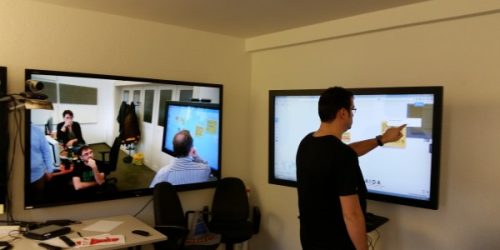10 ways to make distributed Scrum fail

In our workshops we sometimes ask how to make a distributed Scrum project fail. We’ve gathered the most important ideas and created a top 10 list for you. You will be impressed how easy it is to ruin distributed work.
Dieser Artikel in Deutsch: 10 Dinge, um verteiltes Scrum scheitern zu lassen
1. Talk is silver, silence is golden.
You should be glad to work in a distributed team, because conversation can be reduced to a minimum. Enjoy the silence. Stay offline and work very concentrated on your own topic and create a fait accompli. Whenever you have a problem solve it on your own. Remember, conflicts are also solved without action over time.
2. Communicate by email only.
Today, mailboxes offer enough space for everything such as images, videos or other kinds of documents. Keep writing mails in the length of twitter messages or at least about 1,000 words without punctuation characters. Important parts should be written in capital letters so that everyone knows about their significance. Exclamation marks are underestimated too. Don’t use the subject field and drop salutations. There’s no need to use them because you are a team.
3. Don‘t use videoconference.
Stick to your individuality by not using the camera. If you’ve accidentally turned it on, turn off the microphone to slander about your colleagues. Hide yourself or act like someone else is with you who cannot be seen by anyone else. You should also try having some sweets or other dainties in front of everyone. It is most enjoyable if your colleagues don’t have anything like you.
4. You are important. Let everyone know!
When you are on the phone use the time to be productive. E.g. answer mails, read articles or browse the internet. You should produce keyboard noise while typing, so everyone knows that you are the busiest member of the team. Eat some cookies and drink some bubbling water. Always argue about the purpose of the current meeting. Interrupt your colleagues and tell them you don’t have time. Don’t ask if you missed something and never say anything which shows your acceptance or appreciation.
5. Your workplace should appear alive.
Put your microphone near your pc fan. Open the window if you have a busy road in front of your office. In addition, very small rooms or open space offices are the perfect environment for videoconferences. Take care of having a small bandwidth so no one wants to use collaboration tools or videoconference.
6. Collaboration tools? Awful idea.
Print your documents and always take notes on paper. If you are familiar with visualization techniques always use a whiteboard or flipchart. Remember – this should not be visible to any camera. Promise you’ll instantly take pictures and share them with your colleagues. However, it is best practice to wait at least one week before sending them around. Don’t put anything into an online wiki. Your colleagues would probably start to read it and benefit from your knowledge.
7. Separate your team based on features and function.
Everyone does what he’s best at. Separate development from testing to reduce unnecessary communication. Prevent knowledge exchange. Let everyone feel that they are the only experts on specific areas. Only answer questions by email if your boss got a copy of it.
8. Prevent your team from evolving a common identity.
Always talk about business or current problems. Don’t meet face to face – that saves time and money. Meetings should be created at random times each week and you should always be late. Start searching for your headset when the meeting has already started and let everyone know that you’re not ready yet. Once the headset is found remark that there are other projects you should work on. Don’t take problems of your colleagues seriously.
9. Enhance mistrust.
Use insinuations and don’t use a common language. Point at your colleagues if something was not delivered in time. On the other hand you should never let colleagues participate in decisions. Show everyone that you always win out because you are at the decision maker’s location, have the higher salary and the better equipment.
10. Do not use Scrum.
Scrum doesn’t work for distributed teams anyway. Ask the gurus! If your boss requests Scrum you should at least put the Scrum Master aside. If you cannot avoid having a Scrum Master he should always be at the same location. Don’t have deputies for him at other locations, he should manage that himself. Don’t reflect on your methods, use best practices like this article. Always look forward and never look back. A retrospective is just some kind of cheap psychotherapy and is not necessary for you, your team is doing fine. Additionally daily synchronization is overrated; one task can sometimes take a week so there’s no need for dailies. This would contradict the first rule anyway.







